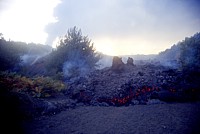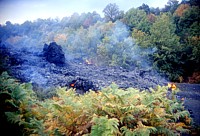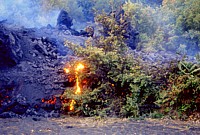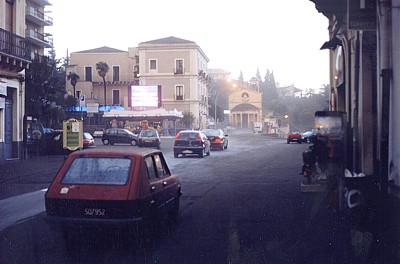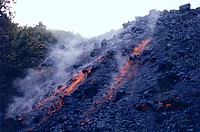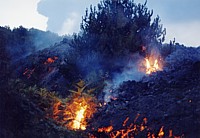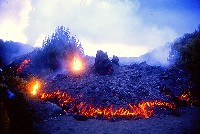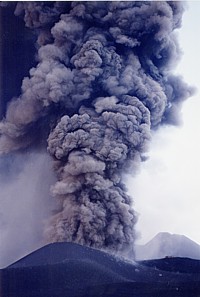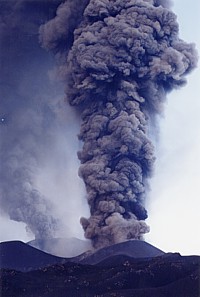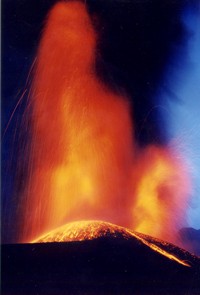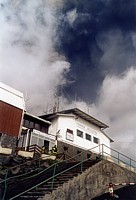 |
Lava
flow on the northeastern flank, 1 November 2002
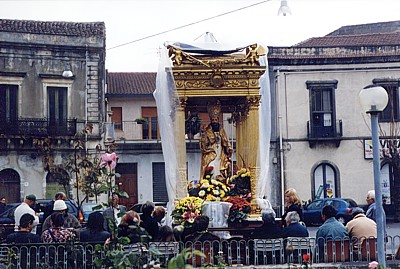 |
| Statue
of the patron saint of the town of Linguaglossa, Sant'Egidio,
posted at the margin of the town facing the erupting volcano.
Linguaglossa lies on the northeastern side of Etna, in full view
of the Northeast Rift eruption, and during the first days of the
eruption, lava flows advanced alarmingly fast in the general direction
of the town. On 1 November 2002, when this photo was taken by
Pippo Scarpinati, the activity at the Northeast Rift had markedly
diminished and all lava flows except one had stopped, and the
remaining active flow was advancing at a speed of a few meters
per hour. Nonetheless, Sant'Egidio was left guarding for another
few days |
Northeast
flank, 2 November 2002
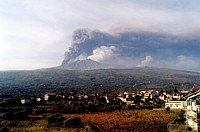 |
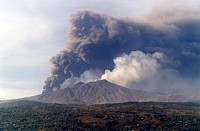 |
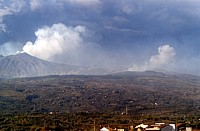 |
Views
of Etna from Linguaglossa on the morning of 2 November 2002, showing
voluminous ash production at the south flank vents (the shifting
wind is now driving the ash to the northwest, thus far spared
from ash falls of the eruption), gas emission but no longer explosive
activity at the summit craters, and much reduced eruptive activity
on the Northeast Rift (shown in detail in the right photograph) |
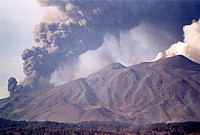 |
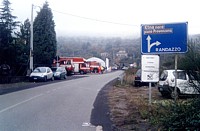 |
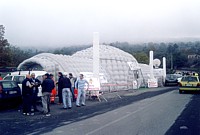 |
Left
image is a zoom on the summit area and the ash plume rising from
the explosively active vents on the southern flank (the vents
themselves are hidden behind the slope of the volcano). Note the
dense yellowish gas plume rising from the Northeast Crater (at
extreme right) and the slightly lower cone of the Southeast Crater
in the center of the image, which has remained absolutely inactive
during this eruption, in contrast with its involvement in the
2001 eruption. The photographs at center and right were taken
at the beginning of the "Mareneve" road near Linguaglossa,
where a roadblock had been placed, along with a remarkable temporary
hospital, which remained standing there for a couple of weeks
afterwards, although the Northeast Rift eruption ended three days
after these photographs were taken (2 November 2002)
Nota bene: if you ever happen to come to Etna's
northern flank, follow the indications given on the white sign
in the center photograph (Pizzeria "Sciaramanica").
You will not find equally sized and tasty pizzas anywhere else
on Earth, and surely none prepared for you by a true geologist! |
South
flank, 2 November 2002
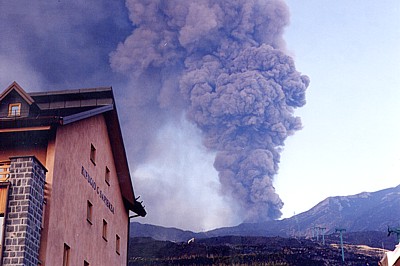 |
| Bad
signs in the sky: a dark column of ash is towering above the building
of the Rifugio Sapienza on Etna's southern flank on 2 November
2002. The building, which had been completely restructured and
was ready for re-inauguration in July 2001, had been seriously
threatened by the lava flows of the eruption of that year. Now,
little more than one year later, there's a new eruption under
way, not far away from the crater that sent out the menacing lava
flows in 2001. But so far this new eruption has produced only
a short-lived lava flow on the southern flank, which stopped three
days before this photo was taken by Pippo Scarpinati |
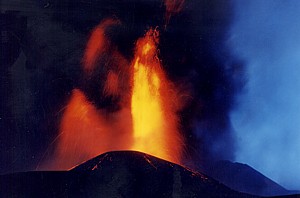 |
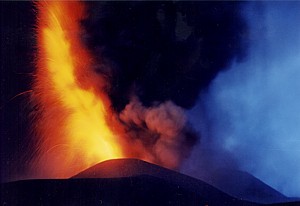 |
Fire
fountaining from the new pyroclastic cone at 2750 m elevation
(this is the elevation of the terrain in that place before the
eruption, not that of the cone itself) on the evening of 2 November
2002, photographed by Pippo Scarpinati |
South
flank, 3 November 2002
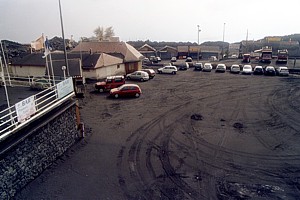 |
|
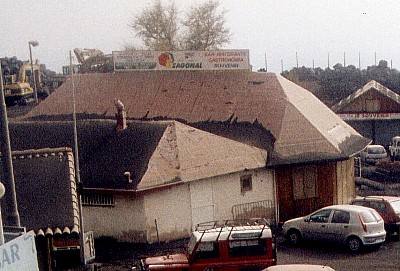 |
Scenes
from the tourist complex at the Rifugio Sapienza on the southern
flank of Etna, 3 November 2002. Top left shows the parking lot
lying below the departure station of the cable car, thickly covered
with ash of the eruption initiated one week earlier. The building
in left background of that image (shown enlarged below) is the
restaurant "Esagonal", which fell victim to the eruption
a few weeks later, when lava covered a fuel or water container,
causing an explosion. Flying debris from the incandescent lava
fell on the restaurant building, setting it ablaze. Top right
photograph shows the black ash plume from the upper south flank
vent darkening the sky above the departure station of the cable
car |
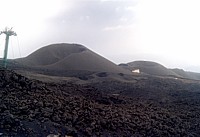 |
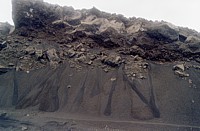 |
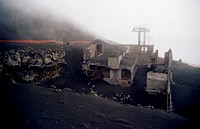 |
During
the hike to the new eruptive sites on the southern flank on 3
November 2002, there are few little but interesting things to
see. Left image shows the landscape so well known to thousands
of tourists who visit Etna in "normal" times: the large
scenic pyroclastic cones of the Monti Silvestri, formed during
an eruption in 1892 (which, judging from the size of those cones,
must have been pretty explosive as well, but back in 1892 the
ash falls did not strike a society as vulnerable as that of 2002).
In the foreground there is one of the lava flows of 2001, now
being buried by the ash of a new eruption, and a surviving pole
of the cable-car stands at left.
Center image shows miniature slides in the fresh ash deposits
covering a steep slope next to the dirt road leading upslope from
the Rifugio Sapienza area. These slides are triggered by the rapid
accumulation of ash on a steep surface, not by seismic activity
or rainfalls (no rain has fallen on Etna since the beginning of
the eruption one week earlier).
There's quite some irony related to the photograph at right. It
shows what remained of the arrival station of the cable car, which
had been set ablaze by two small lava flows during the 2001 eruption
and on this occasion transformed into an impressive ruin. For
one year the ruin was a remarkable museum of destruction (see
the post-2001 eruption photographs), and then, in September 2002,
the company owning the cable car broke the ruin down, leaving
only the foundations, which are still visible in the photograph
at right. This was intended as the start of reconstruction, but
before this could be effectively carried out, the new eruption
began, and first the place was covered with ash. Then, at the
end of 2002, lava flows from the new eruption covered the site
for good, piling up to a thickness of 20 m. |
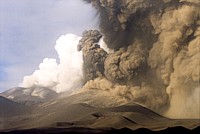 |
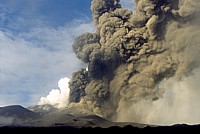 |
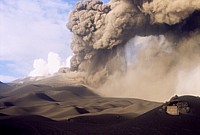 |
Vigorous
ash emission from the growing cone on the upper southern flank
on 3 November 2002, seen from south, with the summit craters in
the background. White vapor plume comes from the Bocca Nuova.
Left photograph shows three smaller, inactive pyroclastic cones
in front of the active one; these formed during the first days
of the eruption when a fissure with a total length of 1 km was
active. Dark cone at extreme left in center photograph is the
prehistoric Monte Frumento Supino; note that at the time these
photographs were taken it was still considerably higher than the
new cone - now, after the end of the 2002-2003 eruption it is
considerably lower.
There's again some taste of irony in what the photo at right is
showing. About one month before the beginning of the new eruption,
in mid-September, a decision was made by the Etna Natural Park
direction to give a name to the huge pyroclastic cone formed during
the 2001 eruption in the place that was formerly known as the
Piano del Lago. There had been much discussion about naming that
cone, and proposals varied from "Montagnola 2" and "Cono
del Lago" or "Cratere del Laghetto" to "Monte
Tazieff". The decision that was eventually made surprised
everybody. The name declared officially on 29 September 2002 was
Monte Josémaria Escrivà (after a Spanish priest,
founder of Opus Dei, who was to be canonized by the Pope a few
days afterwards). On that day, a plate was fixed on a chunk of
lava erupted in 2001, which at the same time symbolized the inauguration
of a hiking path to the cone. The plate, visible in the lower
right corner of the photograph at right and shown enlarged in
the large version, says "Sentiero per il Monte Josémaria
Escrivà" (footpath to Monte Josémaria Escrivà).
Originally fixed at the height of an average person's head, the
plate was about to be buried by the new ash when this photograph
was taken, and now lies under lavas erupted later during the 2002-2003
eruption |
Continue
(next page)
Return
to the Etna photo gallery
|
![]()
